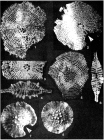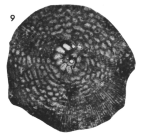Foraminifera taxon details
Vaughanina Palmer, 1934 †
722376 (urn:lsid:marinespecies.org:taxname:722376)
accepted
Genus
Vaughanina cubensis Palmer, 1934 † (type by original designation)
- Species Vaughanina barkeri Brönnimann, 1954 †
- Species Vaughanina cubensis Palmer, 1934 †
- Species Vaughanina guatemalensis Brönnimann, 1958 †
- Species Vaughanina jordanae Brönnimann, 1958 †
- Species Vaughanina hungarica Sidó, 1952 † accepted as Involutina hungarica (Sidó, 1952), emend. Schlagintweit & Piller, 1990, emend. Rigaud et al., 2023 †
marine, brackish, fresh, terrestrial
fossil only
feminine
Palmer, D. K. (1934), Some large fossil foraminifera from Cuba. <em>Memorias de Ia Sociedad Cubana de Historia Natural "Felipe Poey".</em> 8: 235-264.
page(s): p. 240 [details] Available for editors [request]
[request]
page(s): p. 240 [details] Available for editors
Hayward, B.W.; Le Coze, F.; Vachard, D.; Gross, O. (2024). World Foraminifera Database. Vaughanina Palmer, 1934 †. Accessed at: https://marinespecies.org/foraminifera/aphia.php?p=taxdetails&id=722376 on 2024-04-27
Date
action
by
original description
Palmer, D. K. (1934), Some large fossil foraminifera from Cuba. <em>Memorias de Ia Sociedad Cubana de Historia Natural "Felipe Poey".</em> 8: 235-264.
page(s): p. 240 [details] Available for editors [request]
[request]
basis of record Loeblich, A. R.; Tappan, H. (1987). Foraminiferal Genera and their Classification. Van Nostrand Reinhold Company, New York. 970pp., available online at https://books.google.pt/books?id=n_BqCQAAQBAJ [details] Available for editors [request]
[request]
page(s): p. 240 [details] Available for editors
basis of record Loeblich, A. R.; Tappan, H. (1987). Foraminiferal Genera and their Classification. Van Nostrand Reinhold Company, New York. 970pp., available online at https://books.google.pt/books?id=n_BqCQAAQBAJ [details] Available for editors
 Present
Present  Inaccurate
Inaccurate  Introduced: alien
Introduced: alien  Containing type locality
Containing type locality
From editor or global species database
Diagnosis Test lenticular, bilocular juvenarium followed by five to twenty-seven uniserial chambers in a low trochospire and with rudimentary peripheral sulcus, neanic stage with single equatorial layer of annular chambers surrounding the early spire, two alternating systems of vertical radial plates, separated by a narrow gap, project from roof and floor into the equatorial layer, equatorial layer partially covered on both sides by lateral layers of regular tiers of chambers separated by pillars, but in the peripheral part of the outer flange numerous radial plates remain exposed and project slightly as a delicate pectinate margin, large radial stolons pierce the annular walls near the floor and roof of the equatorial layer, stolons and fine pores connect the equatorial layer with chambers of the lateral layers, and lateral chambers are similarly interconnected. U. Cretaceous (U. Campanian to Maastrichtian); Cuba; USA: Florida; Mexico; Guatemala; Venezuela. (Loeblich & Tappan, 1987, Foraminiferal Genera and Their Classification) [details]

